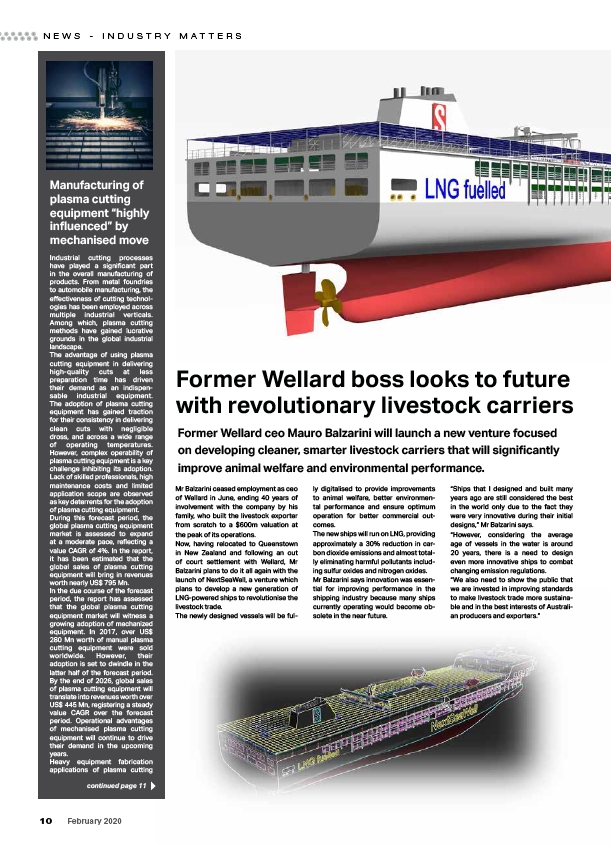
N E W S - I N D U S T R Y M A T T E R S
10 February 2020
Former Wellard boss looks to future
with revolutionary livestock carriers
Former Wellard ceo Mauro Balzarini will launch a new venture focused
on developing cleaner, smarter livestock carriers that will significantly
improve animal welfare and environmental performance.
Mr Balzarini ceased employment as ceo
of Wellard in June, ending 40 years of
involvement with the company by his
family, who built the livestock exporter
from scratch to a $600m valuation at
the peak of its operations.
Now, having relocated to Queenstown
in New Zealand and following an out
of court settlement with Wellard, Mr
Balzarini plans to do it all again with the
launch of NextSeaWell, a venture which
plans to develop a new generation of
LNG-powered ships to revolutionise the
livestock trade.
The newly designed vessels will be fully
digitalised to provide improvements
to animal welfare, better environmental
performance and ensure optimum
operation for better commercial outcomes.
The new ships will run on LNG, providing
approximately a 30% reduction in carbon
dioxide emissions and almost totally
eliminating harmful pollutants including
sulfur oxides and nitrogen oxides.
Mr Balzarini says innovation was essential
for improving performance in the
shipping industry because many ships
currently operating would become obsolete
in the near future.
Manufacturing of
plasma cutting
equipment “highly
influenced” by
mechanised move
Industrial cutting processes
have played a significant part
in the overall manufacturing of
products. From metal foundries
to automobile manufacturing, the
effectiveness of cutting technologies
has been employed across
multiple industrial verticals.
Among which, plasma cutting
methods have gained lucrative
grounds in the global industrial
landscape.
The advantage of using plasma
cutting equipment in delivering
high-quality cuts at less
preparation time has driven
their demand as an indispensable
industrial equipment.
The adoption of plasma cutting
equipment has gained traction
for their consistency in delivering
clean cuts with negligible
dross, and across a wide range
of operating temperatures.
However, complex operability of
plasma cutting equipment is a key
challenge inhibiting its adoption.
Lack of skilled professionals, high
maintenance costs and limited
application scope are observed
as key deterrents for the adoption
of plasma cutting equipment.
During this forecast period, the
global plasma cutting equipment
market is assessed to expand
at a moderate pace, reflecting a
value CAGR of 4%. In the report,
it has been estimated that the
global sales of plasma cutting
equipment will bring in revenues
worth nearly US$ 795 Mn.
In the due course of the forecast
period, the report has assessed
that the global plasma cutting
equipment market will witness a
growing adoption of mechanized
equipment. In 2017, over US$
280 Mn worth of manual plasma
cutting equipment were sold
worldwide. However, their
adoption is set to dwindle in the
latter half of the forecast period.
By the end of 2026, global sales
of plasma cutting equipment will
translate into revenues worth over
US$ 445 Mn, registering a steady
value CAGR over the forecast
period. Operational advantages
of mechanised plasma cutting
equipment will continue to drive
their demand in the upcoming
years.
Heavy equipment fabrication
applications of plasma cutting
“Ships that I designed and built many
years ago are still considered the best
in the world only due to the fact they
were very innovative during their initial
designs,” Mr Balzarini says.
“However, considering the average
age of vessels in the water is around
20 years, there is a need to design
even more innovative ships to combat
changing emission regulations.
“We also need to show the public that
we are invested in improving standards
to make livestock trade more sustainable
and in the best interests of Australian
producers and exporters.”
continued page 11